Jubilee Calendar Testifies of Christ
by John P. Pratt
Reprinted from Meridian Magazine (17 Nov 2004)
©2004 by John P. Pratt. All rights Reserved.
Index,
Home
The Jubilee Calendar is proposed as a restoration of an ancient inspired version, with
evidence that it is used by the Lord for many sacred events.
Many sacred calendars have been described in earlier articles in this column of Meridian Magazine.
One of those was the Enoch Calendar,[1] which divides the year into twelve parts, called months,
very similar to our modern Gregorian calendar. The Lord not only divides time into twelve parts,
he also divides it into seven parts. Examples are the seven-day week, the Hebrew week of seven
years, and the division of the history of Adam's descendants into seven millennia of about 1,000
years each. So the question arises, is there a yearly calendar which divides the year into seven
parts? The answer is yes, several ancient calendars did so. This article introduces the Jubilee
Calendar, which is an attempt to restore what might have been the lost original inspired version. Several examples of its apparent use throughout history are given to show that it is indeed a good candidate to be a sacred calendar actually used by the Lord.
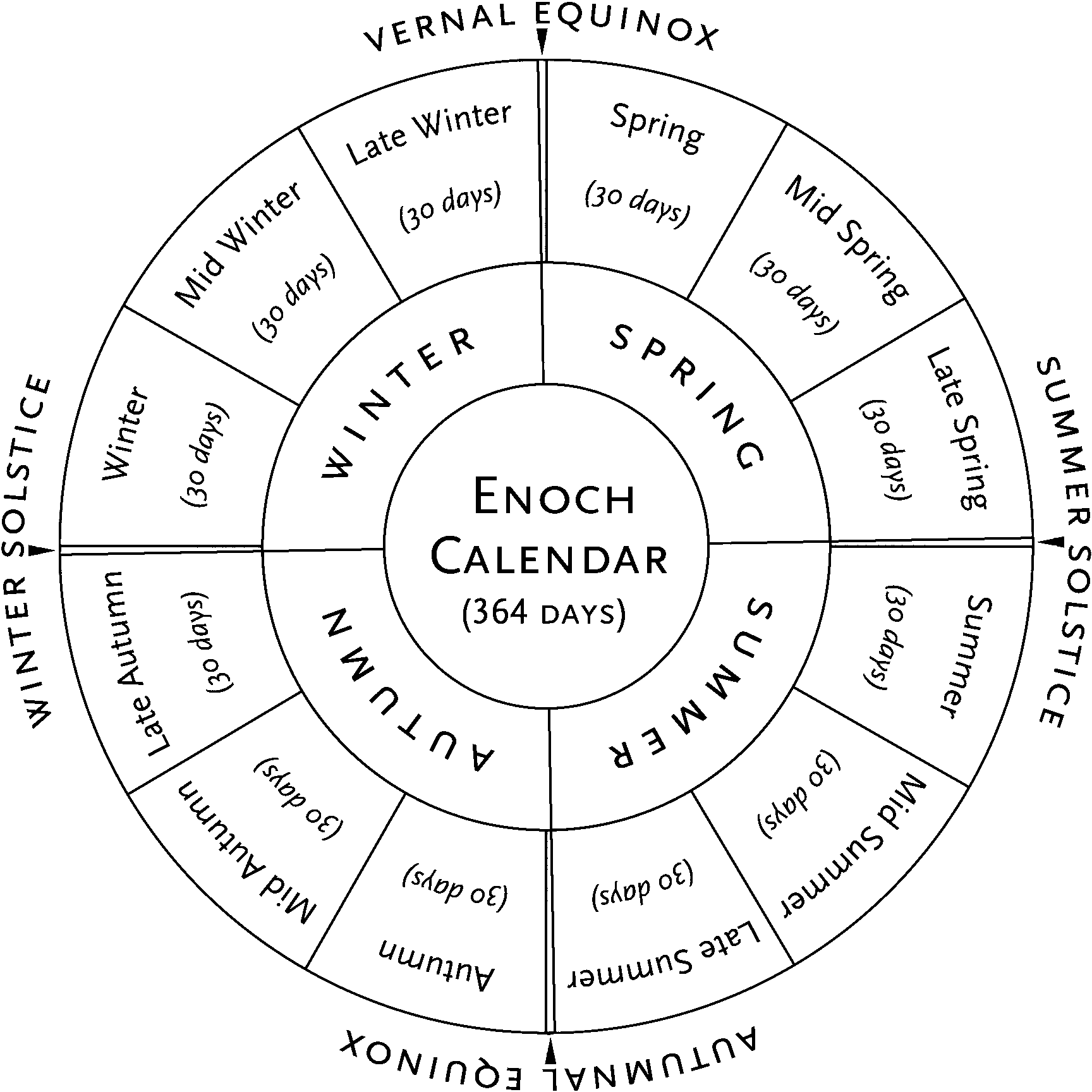 |
The Enoch Calendar divides the year into twelfths.
1. The Jubilee Calendar
Those who have researched the calendars of ancient Israel have found that anciently the Israelites
used a calendar which divided the year into seven parts. Let us consider the main features of the
principal example which has survived, to see if we can deduce what an inspired original version
might have been.
1.1 Pentecontad Calendar
The great Hebrew scholar Julian Morgenstern was one of the foremost experts on the calendars of
Ancient Israel. He concludes there is strong evidence that such a calendar, called the Pentecontad
calendar, was used in Palestine during the time of Moses, and more likely even earlier, at the time
of Abraham. While many of the details of this calendar have long been lost, he describes a similar
calendar which has been used by modern Christian Palestinian peasants.[2]
The calendar is described as dividing the year into seven seasons of 50 days each (350 days) with
two extra weeks inserted at the middle and end of the year. Most scholars have dismissed this
early calendar as a primitive attempt to track the year, which was replaced by the more
sophisticated Hebrew calendar of today. But to me it was intriguing that it appeared to be an
excellent candidate to be a bona fide sacred calendar that the Lord might employ. The following
table summarizes the names of the seasons and activities prescribed. The nominal value of 50 days
for each season was sometimes adjusted in order to start on the Festivals indicated.
| Beginning Day | Length
(days) | Julian | Activity prescribed |
|---|
| Easter | 50 | | harvest lentils and vetches |
| Pentecost | 50 | | harvest barley and wheat |
| Festival of Elijah | 50 | 20 Jul | harvest grapes |
| Festival of the Cross | 50 | 14 Sep | harvest olives |
| Tabernacles Week | 8 | | |
| Festival of St. George | 50 | 3 Nov | plowing, sowing |
| Christmas | 50 | 25 Dec | winter rain |
| Lent | 50 | | |
| Passover Week | 7 | | |
| TOTAL | 365 | | |
Table 1. A modern Palestinian version of the ancient Pentecontad calendar.
1.2 Interval of 49, not 50
The ancient calendar is described as dividing the year into 50-day seasons, and also the jubilee is
described in scripture as reckoning 50-year periods. As has been discussed in detail earlier,[3] the
Lord says he counts a year to a day, and so whatever pattern he uses for the day should match that
for the year also. As also described in earlier papers, the Lord counts the first as the last and the
last as the first, and so it turns out that these are really what we would call 49-day seasons and
49-year jubilees, because the 50th is the same as the 1st.
The one common element between the Jubilee Calendar and the Hebrew calendar is the feast of
Pentecost, and it illustrates the point. The Sadducee sect of the Jews at the time of Christ held the
ceremony of offering the firstfruits of barley on the Sunday after Passover. That is the equivalent
of our modern Easter and indeed usually occurs on our Easter Sunday. Counting that day as day
number one, they then counted fifty days, and celebrated the Firstfruits of the wheat harvest on the
Sunday that was seven weeks later.[4] The "Pente" in "Pentecost" refers to fifty. The festival was
also called the "Festival of Weeks" because it was held seven weeks (49 days) after the first.
So even in ancient times it was thought of as both 49 and 50. In our modern
way of thinking, we would say the festival is seven weeks or 49 days later. The important point
here is that the year in the Lord's calendar would be divided into seven seasons of 49 days each,
with the first day of each season also considered to be the 50th or last of the previous season.
Similar, jubilees are really 49 years long, but the first year is counted as the 50th, or jubilee year,
of the preceding group. If this concept is confusing, then simply think of it the modern way that
there are 49 days in a season, and 49 years in a jubilee. It is easy to see how the calendar could be
corrupted to have 50-day seasons rather than 49.
If there are only 49 days in a season, then the year must have three extra weeks added to make 364 days
total, because 7x49 + 3x7 = 364. The week-long festivals of Passover and Tabernacles on the
Hebrew calendar provide a precedent to add two extra weeks to the year. But what about the third
week? Here the Temple Scroll from the Dead Sea Scrolls provides an answer, and it also provides
us the names of some of the seasons.
 |
The Temple Scroll.
1.3 The Temple Scroll
The Pentecontad calendar has been all but forgotten as a useless curiosity, but now the Dead Sea
Scrolls have been discovered, which shed much new light on this entire subject. In particular, it
was found that the community residing at Qumran near the Dead Sea had gone there to practice
their own ordinances and rituals according to their own calendar. That calendar was their
interpretation of the Enoch Calendar, now referred to as the Qumran Calendar. The Enoch
calendar begins the 364-day year near the spring equinox, and divides into quarters and also twelve months of 30 days each.
One document which was particularly enlightening concerning the rituals was the Temple Scroll.
When it was translated, it was expected to find how that sect used their calendar to determine the
usual Hebrew holy days. Remember that the usual holy days include only one pair which is
separated by 49 days, namely from the offering of the barley (the Sunday after Passover, but not
considered a holy day) to Pentecost or Firstfruits, a major holy day, also always on Sunday. The
translator was "astonished" to find no less than four Firstfruits Festivals, all of which occurred on
Sundays, all separated by exactly seven weeks.[5] The first was that the offering of the barley had
been promoted to a full-fledged holy day of the Firstfruits of Barley. The usual Firstfruits was
called the Firstfruits of Wheat, followed by the Firstfruits of Wine, and finally the Firstfruits of
(Olive) Oil. Had he been familiar with the Pentecontad calendar, he would not have been shocked,
because here we see many similarities. The law of Moses explicitly commands to officially present
to the priest the firstfruits of grain, wine and oil (Deut. 18:3-4). The scripture definitely refers to
waving the sheaf of the firstfruits (of barley) on the morning after the sabbath of Passover (Lev.
23:11), which no doubt was the basis of the Qumran addition of this title for the holy day.
Another major contribution of this scroll is to describe a third one-week ritual, which is exactly
what is needed to complete a 364-day year of seven 49-day seasons and three one week festivals.
It was called the Wood Offering, and it describes in detail how new wood would be brought on
each day of that week by two different tribes,[6] to be used for the burnt offerings throughout the year.
We now have enough information to propose the Jubilee calendar, which combines the division of
the entire year into sevens from the Pentecontad calendar, with the season names and lengths from
the Qumran Calendar, along with their beginning on Sundays.
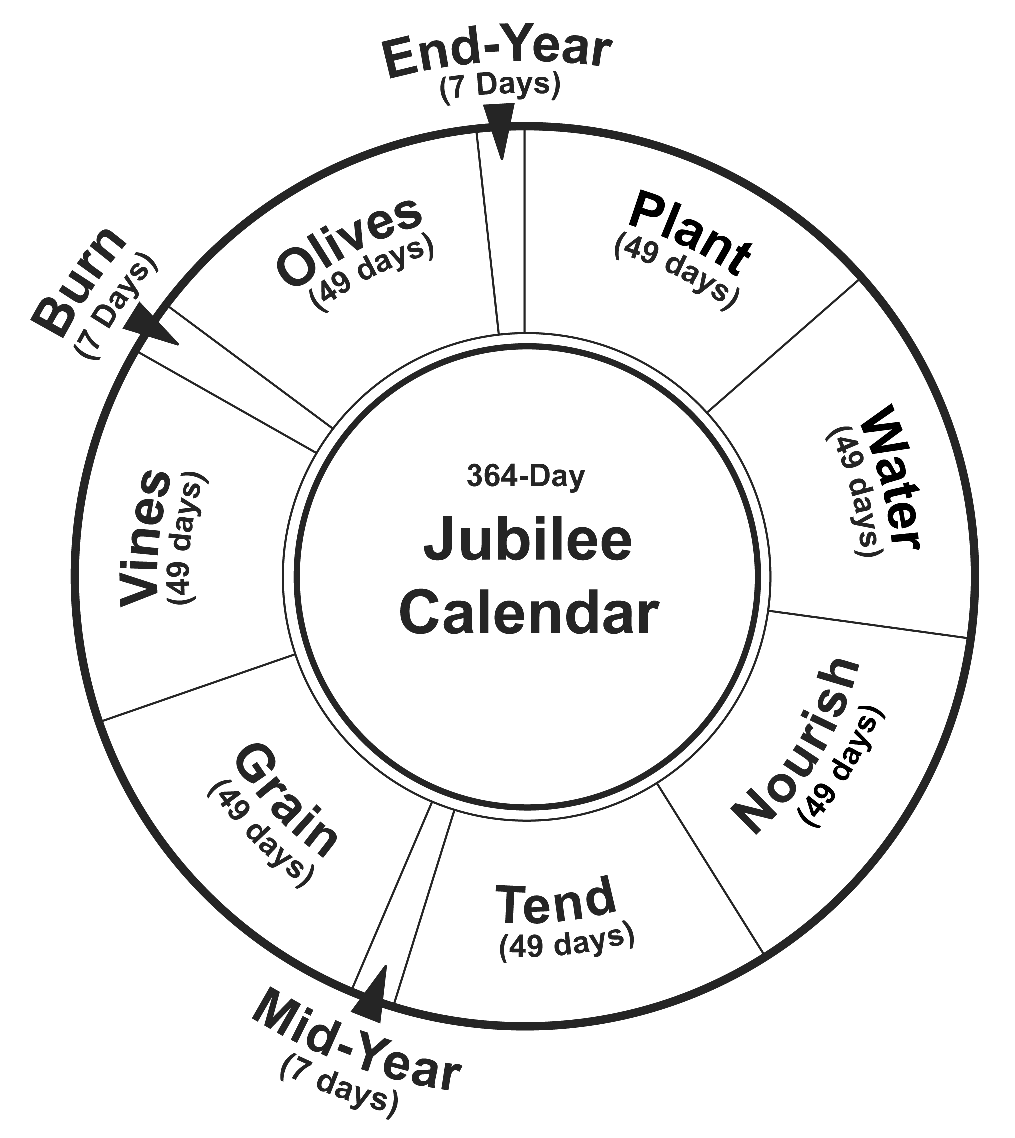 |
The Jubilee Calendar divides the year into sevenths.
1.4 Jubilee Year Divisions
Putting together all of the information into one single proposed model results in the following. The
year has seven seasons of 49 days plus three extra weeks, for a total of 364 days. All are named
for the agricultural cycle. Every season begins on a Sunday. Because the true seasonal year has
365.24 days, an extra week is added to the End-Year Festival every few years according to a set pattern
so that the average year length stays aligned with the seasons.
The agricultural cycle in Jerusalem was based on winter wheat, with the Planting season in the
fall, beginning in late September, so we will put the beginning of the Jubilee year in the fall.
Winter is the rainy season (Watering), and the wheat harvest is in the spring, in May. The
wine harvest comes in the summer, and the olive oil harvest in early fall. The following table
summarizes the Jubilee year and its approximate relationship to our year. It also gives a one-letter
abbreviation for each season, which will be useful in indicating days. Note that the Wood Offering
has been renamed the Burning, because that fits better with the agricultural theme of burning of the
tares of the fields after the grain has been harvested. Also, it has been
moved to occur before the Olive Harvest because when these names are applied to the seven
millennia of history, it is clear from the scriptures that the burning of the fields occurs just before
the Second Coming of Christ, which commences the last millennium of the Olive Harvest (Mat.
13:37-40; 2 Peter 3:10-12; Mal. 4:1; Daniel 7:11-14; Rev. 17:16, 18:8, Isa. 64:1-2, Nahum 1:5).
Olive oil was used to represent spirituality, very fitting for the righteousness of that coming
era. It is the Festival of Ingathering (Tabernacles) which occurs at the very end of the year (Ex.
23:16, 34:22), and it is renamed the End-Year Festival for the Jubilee calendar. Similarly the week
corresponding to Passover Week in spring has been renamed the Mid-Year Festival, because the
year begins in the autumn. Moreover, that name helps remind us of the Meridian of Time, when
the First Coming of the Savior occurred. The names of the first four seasons were taken both from
the Pentecontad Calendar, the Qumran calendar, and from scripture. Deut. 11:14 mentions that the
first rain and latter rain would be given to grow grain, wine and oil. I believe the "first rain" refers
to the second season, and the "latter rain" refers to the fourth season. I renamed those seasons
Watering (to be more general) and Tending/Transplanting because that seems to be the activity of
the scattering of the tribes of Israel during that millennium. Nourishing is also a name I invented to
summarize the gardening activity done at that time, and it seemed to fit what Moses was doing
during the third millennium. The name Wine was changed to Vine to give a distinct one letter
abbreviation, and Oil to Olives to avoid confusion with petroleum. The following table
summarizes the proposed Jubilee calendar model.
| Jubilee Season | Ab. | Length | Gregorian |
|---|
| Planting | p | 49 | Sep - Oct |
| Watering | w | 49 | Nov-Dec |
| Nourishing | n | 49 | Jan-Feb |
| Tending/Transplanting | t | 49 | Feb-Mar |
| Mid-Year Festival | m | 7 | Mar-Apr |
| Grain Harvest | g | 49 | Mar-Apr |
| Vine (Wine) Harvest | v | 49 | May-Jun |
| Burning the Fields | b | 7 | July-Aug |
| Olive (Oil) Harvest | o | 49 | Aug-Sep |
| End-Year Festival | e | 7 | Sep-Oct |
| TOTAL | | 364 | |
Table 2. The proposed Jubilee Calendar.
1.5 Calendar of Sevens
Note that this calendar is based almost entirely on sevens. That is, the seven-day week can be
thought of as a miniature of these seven seasons, where Sunday is Planting, Monday is Watering,
etc. Each week of seven days can also be named similarly, so that the first week of any season is
Planting, the second Watering, etc. Thus, the days of the year can be indicated by three letters,
such as "pnt." In this example, the first letter "p" (for Planting) means the day is in the first season
of 49 days in the autumn. The second letter "n" (for Nourishing) means that the day is in the third
week of that season. And the final letter "t" means that the day is the fourth day (Wednesday) of
that week. Thus, every day of the year can be represented by only three letters, similarly to how it
can be represented by two numbers for the month and day in our usual notation (such as 10/21 for
Oct. 21).[7]
The same pattern can be repeated for larger time units. For example, the years are counted by
sevens, the same as in the Hebrew calendar, and those weeks are counted by sevens to form the
49-years of the jubilee. Thus a year can be indicated by using capital letters, so that PP refers to
the first year of the jubilee, and OO refers to the last. The process can even be continued so that
each millennium is also numbered. Thus Adam lived in the Planting millennium, Noah and the
Flood in the millennium of Watering, Moses nourished the tender plants, Jeremiah
worked on tending and transplanting, the Savior's first coming occurred during the Mid-Year
Festival at the Meridian of Time, then the early Christian Church thrust in their sickles to harvest
the wheat, the next millennium of Christians are workers in the vineyard, then comes the burning
of the wicked and the Second Coming, followed by the Millennium of harvesting the Olive Oil. The great and final victory over evil after the
Millennium is represented by the End-Year Festival. Thus, every day in history can be accounted
for uniquely in this system of repeating the same simple pattern.
1.6 Sacred Days
What are the holy days on the Jubilee Calendar? As a minimum, the first and last day of each
season is considered a sacred day. Preliminary indications are that there are probably also more
sacred days on this calendar. One example is when all letters are the same.
For example the day "ttt" may be a sacred day, being the fourth day of the fourth week of the
fourth season. The sacredness increases when the day is the same in the week of years and
jubilee. For example, the day the Brazen Serpent was raised by Moses in the wilderness was most
likely the day OOooo, meaning the seventh day of the seventh week of the seventh season of the
seventh year of the seventh week of the jubilee.
1.7 Fixed Jubilee Calendar
Note that the Enoch calendar also has exactly 364-days. Both the Enoch and Jubilee calendars
have two versions. In addition to the usual season version, there is a "Fixed" version of each, to
which no extra weeks are ever added to keep the year in step with the seasons. That means
that the fixed versions rotate through the year. While that might appear confusing, it is a great way
to keep track of days, because there can be no uncertainty about just when the extra weeks are
added. Note that because the Enoch and Jubilee calendars both have 364 days, the fixed versions
of each will always have the same relationship to each other. That means if two holy days coincide
in one year on the Enoch and Jubilee Fixed calendars, then they will coincide every year.
How should the Fixed Jubilee and Fixed Enoch calendars be correlated? One calendar divides the year into quarters and the other into sevenths, so
there will not be many holy days which match each other. There are, however, two holy days
which are always on Sundays not only on the Enoch and Jubilee calendars, but also on the
Hebrew calendar. They are Easter and Pentecost. Moreover, the Hebrew and Enoch
calendars specify that Pentecost occurs exactly 49 days after Easter, which is clearly designed to
match at least two of the holy days on the Jubilee calendar. Thus, it is proposed to correlate Easter
on the Enoch calendar with the beginning of Grain Harvest, and Pentecost with the beginning of
Vine Harvest.
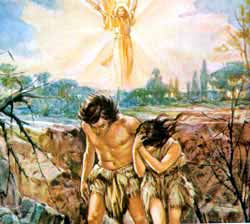 |
Adam and Eve on the Jubilee Passover.
2. Jubilee Calendar Dates
Now let us look at examples of how the Jubilee Calendar has apparently been used throughout
history by the Lord to time certain religious events. These examples will show that the calendar is
rarely used in the timing of births or deaths of his prophets. Instead, it seems to be used for more
secular events which correspond to planting, watering, transplanting, burning, etc.
2.1 Beginning of Mortality
An entire article was devoted to the incredibly important date that Adam and Eve were driven from the Garden of
Eden, on the official beginning date for the Mortality of this entire creation. The proposed date
was the morning of Sun 9 Apr 4001 BC, being Passover on the Hebrew calendar, Easter on the
Enoch calendar, 1 Deer on the Sacred Round, and 1 Creation on the Venus Calendar.[8] Now one
more sacred alignment can be added. That day also began the Mid-Year Festival (Passover) on the
Jubilee Calendar (mpp). So it was a day of many great calendrical alignments.
 |
The Great Flood began on the first day of Watering
2.2 The Flood
One of the clearest examples of the use of the Jubilee calendar is in the timing of the Great Deluge.
That should not be too surprising because the Flood itself is a principal event of the entire
millennium which is named for Watering. The history of the Flood given by the Lord in the Book
of Genesis includes a very detailed account of the exact days on which the rain began to fall, the
day on which the ark rested, and the day on which the land dried. One unusual feature is that
several of the days do not correspond to holy days on any of the sacred calendars reviewed so far
by this author. In an earlier paper, we established the year of the Deluge and the day on which the
rain began to fall beyond any doubt, because the date tied directly to the Baptism of Jesus Christ
and also to the vital dates of Jared, the prophet who symbolized both the Baptism of the Earth and
of Christ.[9]
The subject which was beyond the scope of that article was the meaning of the dates that the rain
began to fall (17 Heshvan), that the ark rested (17 Nisan), and that they left the ark (27 Heshvan).
All three dates are explicitly given in the account (Gen. 7:11, 8:4, 8:14-15), but none of those dates
is considered a holy day by modern Hebrews. So what is the significance of those dates? If they
have no significance, then why did the Lord include them in the sacred history?
The proposed answer is that all three of those dates are holy days on the Jubilee calendar. We have
mentioned above that the last day of one season corresponds to the first day of the next, so the
Watering Season can be thought of as days numbered from 0 to 49 for a total of 50 days. The day
17 Heshvan was the last day of planting, and also the zeroth day of watering. In other words, the
day the rain began fell exactly on the day to begin watering on the Jubilee Calendar. Moreover, the
day on which the ark rested was on the last day of Tending and Transplanting, where the latter
seems especially appropriate for the travelers who had arrived at their new residence. And the day
on which they left the ark was again on the last day of planting, which completed exactly one
364-day year from the beginning of the Flood. Thus, the Jubilee calendar explains all three of those
mysterious dates. The other dates are explained by the other sacred calendars. Note that both of
the "40-day" periods mentioned correspond to the Sacred Round, on which 40 days corresponds
to a unit called the "step."[10]. The following table summarizes all of the dates given in the
account, starting in the year 2343 BC. Note that every single date is a holy day on one of the
sacred calendars. Insignificant days are indicated by no entry, holy days are in bold. The Julian
Day (J.D.) is a continuous number of days used by astronomers, which is included to show that
when the account says 40 days, or 150 days, that exactly that number of days is meant.
| Event | Gregorian | Heb. | S. R. | Enoch | E. F. | Jub. | J.D. |
|---|
| Load Ark | Sat 9 Nov | | 13 Reed | | 14 Aut | | 865,975 |
| Rain starts | Sat 16 Nov | 17 Hes | 7 Flower | | 21 Aut | poo | 865,982 |
| Rain stops | Thu 26 Dec | | 8 Flower | | 1 LAu | | 866,022 |
| End Watering | Sat 4 Jan | | 4 Water | | | woo | 866,031 |
| Ark rests | Sat 12 Apr | 17 Nis | | 21 Spr | | too | 866,129 |
| Water abates | Sat 24 May | 1 Siv | 1 Water | 4 LSp | | | 866,171.4 |
| Mts. appear | Tue 24 Jun | 1 Tam | | | | | 866,202 |
| Raven | Thu 3 Jul | 10 Tam | 2 Water | | | | 866,211 |
| Dove | Thu 10 Jul | 17 Tam | | | | | 866,218 |
| Olive Leaf | Thu 17 Jul | 24 Tam | | | | | 866,225 |
| Dove departs | Thu 24 Jul | 2 Ab | | | | | 866,232 |
| Earth dries | Sat 20 Sep | 1 Tis | | 0 Aut | | ooo | 866,290 |
| Exit Ark | Sat 15 Nov | 27 Hes | | | | poo | 866,346 |
Table 3. Proposed dates of Great Flood events. (Holy days in bold.)
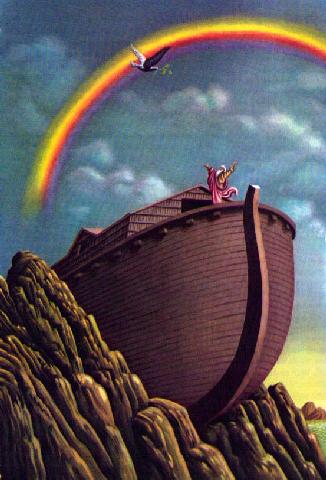 |
The Ark Rested on the last day of Transplanting
There are several items that seem worthy of note in this table. First, note that there are more holy
days listed for the Jubilee calendar than for any other calendar. Second, all three of the mysterious
Hebrew days of 17 Heshvan, 17 Nisan, and 27 Heshvan are explained as being holy days on the
Jubilee Calendar.
The one entry to the table for which a day is not mentioned in Genesis is listed as "End Watering,"
perhaps being when the fountains of the deep were stopped (Gen. 8:2). The interesting thing about
this day is that the Aztec Calendar stone has in the center glyph five huge dates, which represent
five destructions of the world, four of which are past. The destruction by water, presumably the
Great Flood, is represented by the date "4 Water," which has never been taken very seriously,
much less actually explained. As I prepared this article on Sat 13 Nov 2004 (the Jubilee day poo,
as shown on my Sacred Wall Calendar), I discovered that the last day of watering during the Flood
fell exactly on 4 Water. That may just be a chance coincidence because it is the only world
destruction for which I have exact dates. I mention it here mostly as a curiosity, in case the other
destructions provide further witnesses that it was not just chance. Usually my articles only claim
an alignment is meaningful when it is one of a set of at least three, as in the table above.
As for how the above dates were derived, the entire table is anchored to the date the ark was loaded
which is known with certainty. One date somewhat ambiguous in Genesis is that the water abated
after 150 days (Gen. 7:24, 8:3), but after what event? The traditional Jewish interpretation is
counted from when the rain stopped.[11] Following that lead we see that it just happens to end on
a triple holy day, which would have been totally unknown to the Hebrew Bible interpreters. It is a
strong witness that they were correct, especially because one of those holy days is "1 Water." A
similar problem is that the raven was released after forty days (Gen. 8:6), but forty days after
what? The Jewish interpretation was to reckon the 40 days from the water abating on 1 Sivan,
indicating the day 10 Tammuz. Here the Sacred Round bears witness that they again were exactly
right, because 40 days on the Sacred Round is one "short step," and the start date was very meaningful
on the Sacred Round. This is indicated in the table by the water abating on the day "1 Water"
and the raven being released on "2 Water." Again, that corroborates their interpretation because the
Sacred Round was clearly not involved in their interpretation. Because of their success record, I
also followed the traditional Jewish interpretation that the dove was released one week after
the raven, even though that detail is not explicitly stated in Genesis.
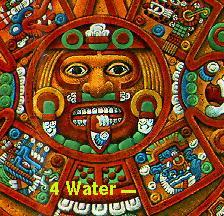 |
The Aztec Deluge date, 4 Water, is shown in the lower right hand rectangle. End Watering occurred on 4 Water during the Flood.
What is the meaning of all of these dates? To me it seems clear that the Flood was the Baptism of
the earth, because its date was tied to the Baptism of Jesus Christ. If so, it could symbolize the "rebirth"
of the earth. Comparing the events mentioned, shows a close correspondence to the events at the
creation. That is, at first the earth was covered with water, involving both waters from above and
from beneath (Gen. 1:7), just as in the Flood. Then one day the first mountain peak arose from the
water, which might represent the day on which the earth began to be born.
That would explain why the very day the first mountain peak appeared is recorded in the Genesis
account of the Flood. And the date on which the ground dried after the Flood might be the day on which the
earth breathed the breath of life and completed the process of its birth. Could the account of the
Flood be telling us also about the dates on which the earth was born? Time will tell.
2.3 Moses
There are several key dates from the life of Moses which indicate that the Jubilee calendar was
being used by the Lord. Let us review some to see how the Jubilee calendar may well have been
employed by the Lord in the timing of sacred events, based on the anchors dates for Moses already
published.[12]
2.3.1 Raising of the Tabernacle. The date on which the tabernacle was raised in the wilderness is
given but it was only sacred on two calendars published before now. It was on the morning of
Sun 13 Mar 1461 BC, which was New Year's Day on the Hebrew calendar (1 Nisan), and the
first day of the priest representing the resurrection on the Priest calendar (1 Jachin). It turns out
that it was also the day to Begin Transplanting on the Jubilee Fixed calendar (tpp), which seems
appropriate as the group was now beginning its journey to the promised land.
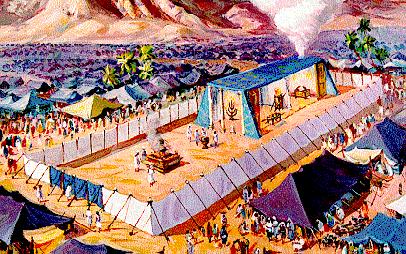 |
The Tabernacle was raised and the Cloud moved on holy days of the Jubilee Fixed Calendar.
2.3.2 Tabernacle Cloud. Another example is a day on which the cloud moved from the tabernacle when the Israelites were being led in the wilderness. That was a day on which the Lord decided to have
them relocate. It is explicitly stated to be 20 Iyar (Num. 10:11). 20 Iyar is not a sacred day on the
Hebrew calendar. Does it have any significance whatsoever? Or was it just a good day to move?
It turns out that the day (Sun 1 May 1461 BC) was exactly 49 days after the tabernacle was raised, and it began the Mid-Year Festival (Passover) on the
Jubilee Fixed Calendar. Whether or not that is just a chance coincidence needs to be determined by
looking at several such dates to see if there is a pattern. So far we have only these two examples,
they are mentioned in case more in the series are discovered.
2.3.3 Transfiguration of Moses. There are several other examples from the time of Moses. The day
of the transfiguration of Moses (Sat 3 Oct 1462 BC) was ewo on the Jubilee Calendar, the last day
of the year, and Great Day of the two-week End-Year Festival (Ex. 34:29-35). As already
published, it was also Tabernacles (Hebrew) and Atonement (Enoch).
2.3.4 Brazen Serpent. The day of the Brazen Serpent was most likely Sat 19 Sep 1423 BC. That day
was OOooo on the Jubilee calendar, the equivalent of the Day of Atonement, in the 49th year of a
jubilee. That was the Jubilee day equivalent to the Hebrew day of Atonement on which a trumpet
was to be sounded announcing the coming 50th year of the Jubilee. Of course, that year the
trumpet was not yet sounded because the Israelites would only begin counting jubilee years after
they entered the promised land. The day was also 13 Serpent on the Sacred Round, the number
perhaps representing the highest that the Serpent could be raised. It was also the Autumn Equinox
(Enoch), the Feast of Tabernacles (Enoch Fixed), and 0 Birth (Mercury), so it was a multiple holy
day, worthy of such a sacred celebration.
2.3.5 Deuteronomy. The day on which the Book of Deuteronomy began to be revealed was most likely Sat 2 Jan
1422 BC, being 1 Shebat (Deut. 1:3). That day was woo on the Jubilee calendar, the last day of
Watering, but also the beginning day of Nourishing, which was a principal responsibility of
Moses.
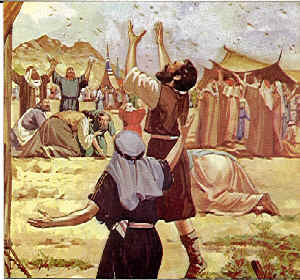 |
The bread from heaven symbolized Christ and was taken back to heaven on Easter on both the Hebrew and Jubilee calendars.
2.3.6 Manna and the Jubilee Year. Finally, the day on which the manna ceased to fall was Sun 18
Apr 1422 BC, being PPgpp the FirstFruits of Grain Harvest on the Jubilee calendar (Easter), in the first year of the jubilee cycle, being the same as the fiftieth, or Jubilee Year. It should here be
mentioned that it was this year, in which the Israelites entered the promised land, that the Lord
apparently designated to begin counting the 50 years of the jubilee (Lev. 25:2-10). This is how the
year of the Jubilee was determined in this proposed model. Modern Jewish scholars have a
traditional reckoning of the 7-year cycle of years, but they do not know when the jubilee year
should be celebrated. The proposal in this article agrees with the traditional Jewish interpretation
of the 7-year cycle, namely that 1423 BC was the seventh year of the cycle. But now we go one
step further and propose that the next year, 1422 BC was a jubilee year (beginning the previous
autumn).
2.4 David and Solomon
The Jubilee calendar sheds light on several dates during the reigns of David and Solomon, many of
which have already been published.[13] First, the date of David becoming the King of all Israel
was not a holy day on the Hebrew calendar, which surprised me. It was Sat 16 Nov 1019 BC,
being 5 Kislev (Hebrew). The day Sat 16 Nov is the same as the day of the Flood on our
Gregorian calendar, but so far I have seen no indication whatsoever that the Lord ever uses our
calendar. It turns out that on the Jubilee calendar, it is indeed the same as the day the rain began
the Deluge, poo. Note that for these calendars to align, the date must fall on the same day of the
week as well as approximately the same day of our year.
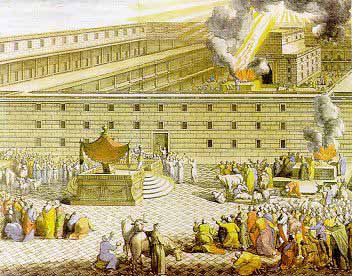 |
The Jubilee Calendar explains the two-week dedication of Solomon's Temple.
Another curious calendrical tidbit is included in the description of the dedication of Solomon's
Temple. It is stated that the Feast of Tabernacles was held for two weeks (1 Kings 8:65; 2 Chron.
7:9). That is never done on the Hebrew calendar, and hence is a puzzling statement. It turns out to
make perfect sense, however, if one is following the jubilee calendar, because the End-Year Feast
is celebrated for two weeks in those years in which the leap-week is added. Hence the date of the
dedication of the temple Sat 19 Sep 973 BC was not only Tabernacles (Hebrew) and the Autumn
Equinox (Enoch) as already published, it was also ooo (Atonement) on the Jubilee calendar.
Similarly, the last day of the two-week dedication celebration (Sat 3 Oct 972 BC) was ewo (Great
Day) on the Jubilee calendar, ending a two week End-Year Festival.
2.5 Temple Burnings
When the temple in Jerusalem was burned for the second time in AD 70, the historian Josephus
made a big point of the coincidence that it was burned on Sun 10 Ab, the same day as the temple
had been burned over six centuries earlier by Nebuchadnezzar.[14] That was interesting to me as a
calendrical cycle researcher, but I found it curious that it occurred one day after 9 Ab, which is the
traditional Fast Day of the Jews, commemorating that destruction among other
things. With the discovery of the Jubilee calendar, the one day discrepancy makes much more
sense. The dates of the burning of the first temple (Sun 24 Jul 587 BC, 10 Ab) and of the second
temple (Sun 3 Aug AD 70, 10 Ab) both also coincide with bpp on the Jubilee calendar, the first
day of the week of burning. Moreover, according to the Temple Scroll cited above, the first day of
burning is for the tribes of Levi and Judah, which seems especially appropriate to be the day to
burn to temple of the Levites in the city of Judah. This to me is a strong vote for the Jubilee
calendar, because the concept of Burning on the Jubilee calendar seems to have overridden the
more obvious alignment with the fast day of 9 Ab just one day earlier. Moreover, it corroborates
the choice of putting the week of Burning before the seventh season of the year.
3. Life of Christ
Examples of the Jubilee Calendar in the life of Christ have been saved for this article's finale. First, it
should be noted that the Jubilee Calendar is less important that the Hebrew Calendar, and is
apparently only used for certain types of events. Those events do not appear to include births and
deaths as a rule, but rather dates of other sacred events such as those associated with caring for a
garden. Let us look at a few dates, the details of which are mostly included, with references, in
my "Religious Chronology Summary" on my web site.[15]
 |
The Annunciation on the Jubilee Firstfruits.
3.1 Annunciation
The already published date of the Annunciation of the Birth of Christ is the birth event which was
apparently scheduled on the Jubilee calendar. That morning was Sun, 13 Jun 2 BC, being
Firstfruits on the Hebrew calendar. But now we see it was also the day OOvpp on the Jubilee
Calendar, also being Firstfruits (of Wine) in the last year before the Jubilee year.
3.2 Christ born in Jubilee Year
Having fixed the Jubilee year as above stated in the year of Joshua leading the children of Israel
into the promised land, we now see that the year of the Savior's birth was also a Jubilee year.
That is, the anchor point for the jubilee year is 1422 BC, when the children of Israel entered the land
of Canaan. Each jubilee is 49 years in length, and 29 x 49 = 1,421. That means that the year 1 BC was
also a jubilee year.
Moreover, it is likely that 1 BC was THE Jubilee year, and what Jubilee is really all about. The symbolism of jubilee was
that all debts would be forgiven, slaves would be freed, and all land would revert back to the
original inheriting family. It was truly a time of celebration, a time to "proclaim liberty throughout
all the land" as is emblazoned on the Liberty Bell (Lev. 25:10-17). Those acts all seem symbolic of
the mission of the atonement of the Savior.
 |
The Baptism of Jesus Christ.
3.3 Birth of John the Baptist
Exactly when did that jubilee begin? It began on Sun 3 Oct 2 BC, the day PPppp on the Jubilee
calendar. That was about six months before the birth of Jesus Christ at Passover of 1 BC. One
cannot help but remember that John the Baptist was born about six months before Jesus (Luke
1:26). For years I have been looking for an opportunity to share with you my proposed date for
the birth of John the Baptist. Now is the time: his birth date was almost certainly on Wed
6 Oct 2 BC, being 10 Tishri (Atonement on Hebrew) and 1 Monkey (Sacred Round), just three
days after the beginning of that all-important jubilee. One reason I've never published this
date is that it is most likely significant on the Mars calendar, and I haven't yet taken the time to
calculate how that calendar works.
That birth date for John the Baptist is exactly on the day on which the trumpet was to sound (Atonement), announcing the Jubilee year on the Hebrew calendar. So it appears that he who
would announce the coming of the Savior was born on the very day that the good news of the
arrival of the jubilee year, the acceptable year of the Lord, should be trumpeted for all to know.
Thus, the birth of John the Baptist was most likely according to the Hebrew calendar and Sacred
Round, as is the case with nearly every birth of a prophet discussed in my articles.
What about the Jubilee Fixed calendar? Is there also an equivalent jubilee year on that
calendar? Yes, on the Jubilee Fixed calendar the jubilee began on Sun 24 Oct 2
BC. It may turn out when the overall plan of seven millennia is better understood, that it was important that on both Jubilee calendars, the Savior's life occurred entirely within one jubilee period. That is, perhaps that jubilee represented the Mid-Year Jubilee of all of history in which the promised
Messiah would come. Those details still need to be worked out.
3.4 Baptism
The Savior's baptism was on one of the most holy days in all of history, being holy on all seven of
the sacred calendars published so far. With the introduction of these two calendars, that statistic is
changed to eight of the nine. The day Sat 6 Oct AD 29 was the Great Day of the End-Year Feast
(epo)on the Jubilee calendar.
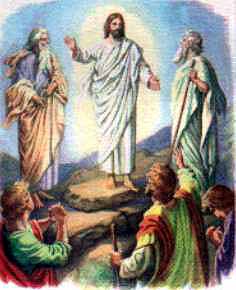 |
The Transfiguration of Jesus Christ.
3.5 Transfiguration
A date equally holy in the Savior's life occurred on the day of his transfiguration on Sat 2 Oct AD
32. It was also holy on all seven sacred calendars published so far. Again, that is now changed to
eight out of nine, because that day was also the Great Day (epo) on the Jubilee calendar. Note that
the transfiguration of Moses occurred on that same sacred day of the Jubilee calendar, Moses
being a type of Christ (Deut. 18:15).
3.6 Resurrection
The Resurrection of Jesus Christ was another of the most holy days discovered so far, also being
holy on all seven sacred calendars hitherto published, with five of those seven dates corresponding
to Easter on that calendar. With the advent of these two calendars it changes to being holy on eight
of nine calendars. Sun 3 Apr AD 33 was the Firstfruits of Wheat on the Jubilee Fixed calendar
(gpp), which is Easter, the Sunday after Passover week. Thus, on six of the nine calendars, it was
the very day representing the Resurrection. This is truly amazing,
because the holy days on the Jubilee calendar divide the year in to seven parts, whereas the holy
days of the Hebrew divide it into four parts, with the exception of Firstfruits. And yet there is just
enough overlap when the one month variation with the moon occurs in the Hebrew calendar,
combined with the one or two week variation with the Enoch and Jubilee calendars, that these
calendars can have so many holy days coincide during such a short lifetime. It is truly a testimony
of the craftsmanship of God in designing our solar system to be such a wonderful timepiece.
4. Conclusion
Concepts from the Pentecontad and Qumran calendar were combined to propose a new Jubilee
calendar, which appears to have been used by the Lord in timing certain sacred events. Those
events do not include birth and death dates of prophets, but rather ordinances such as baptism,
transfiguration and resurrection. The particular evidence supporting the Jubilee calendar concerns
dates specifically mentioned in scripture which were not known to be holy on any other known
calendar. Examples include four days mentioned in the account of the Great Flood. Moreover, both of the burnings of the temple in
Jerusalem are reported to have occurred on a day which corresponds to the Burning on the
proposed Jubilee calendar. Finally, it is seen that the template for the Jubilee year doubles as a
template for the history of the children of Adam, with many of the principal events of earth history
occurring at the proper time, such as the Flood occurring during the millennium for Watering.
Most notable of these events was the life of Jesus Christ, which occurred during the jubilee
at the Meridian of Time. Thus, it is concluded that the proposed Jubilee calendar is another sacred calendar employed by the Lord in timing sacred events, adding yet another witness of our Creator, Jesus Christ.
Notes
- Pratt, John P., "Enoch Calendar Testifies of Christ," Meridian Magazine (11 Sep 2001).
- Morgenstern, Julian, "The Chanukkah Festival and the Calendar of Ancient Israel," part VI, Section A of which is entitled,
"The Pentecontad Calendar in the Ancient Semitic World," Hebrew Union College Annual
(Cincinnati, Ohio: Hebrew Union College, 1948), vol. 21, pp 365 - 374.
- Pratt, John P., "Celestial Witnesses of the Meridian of Time," Meridian Magazine (10 Jul 2002), Section 1.
- The Pharisees, the other main sect of the Jews at that time, offered the firstfruits of barley on the
day after Passover, rather than the Sunday after Passover. They also then counted fifty days the
same way and held Pentecost on the same day of the week as the barley offering, seven weeks
later. The modern Hebrew calendar follows this tradition, but my research indicates that the
Sadducees had it right. See my "Exodus Date Testifies of Christ," Meridian Magazine (7 Oct 2003), Section 3.1.4.
- Yadin, Yigael, The Temple Scroll (New York: Random House, 1985), pp. 84-111. Under the heading "Surprise Feasts" on p. 91 he writes, "After deciphering these verses on the Pentecost and turning my eyes to the next column of the scroll, I was astonished to find myself reading what at first sight appeared to be a repetition of what I had just read."
- In case it turns out to be important, the order was that on the first day Levi and Judah offered
wood (in that order), followed by Benjamin and Joseph, then Reuben and Simeon, Isachaar and
Zebulon, Gad and Asher, and finally on the sixth day Dan and Naphtali. Temple Scroll, pp. 101
102.
- Readers who are mathematically inclined will recognize that this calendar is a slightly modified base 7 system. More research is required to establish exactly how the progression continues to higher multiples of seven.
- Pratt, John P., "Venus and the Beginning of Mortality," Meridian Magazine (9 July 2003).
- Pratt, John P., "Astronomical Witnesses of the Great Flood," Meridian Magazine (13 Aug 2003).
- Pratt, John P. "Exodus Date Testifies of Christ," Meridian Magazine (7 Oct 2003), Section 3.2.1.
- Ginzberg, Louis, Legends of the Jews (Philadelphia: Jewish Publication Society, 1912) vol. I,
p. 163: "The duration of the flood was a whole year. It began on the seventeenth day of Heshwan,
and the rain continued for forty days, until the twenty-seventh of Kislew. . . . From the twenty
seventh of Kislew until the first of Siwan, a period of one hundred and fifty days, the water stood
at one and the same height, fifteen ells above the earth. . . . On the first of Siwan the waters began
to abate, a quarter of an ell a day, and at the end of sixty days, on the tenth [should be "first" -
JPP] of Ab, the summits of the mountains showed themselves. [This is a departure from Genesis
8:5 which says the mountains appeared on the first of Tammuz, the tenth month, rather than Ab,
the eleventh month. Perhaps it was just an error in counting months. Or it could have been an
attempt to correct the record, because perhaps the birds were released before the mountain tops
were seen.- JPP] But many days before, on the tenth day of Tammuz, Noah had sent forth a
raven, and a week later a dove, on the first of her three sallies, repeated at intervals of a week. It
took from the first of Ab until the first of Tishri for the waters to subside wholly from the face of
the earth. Even then the soil was so miry that the dwellers in the ark had to remain within until the
twenty-seventh day of Heshwan, completing a full sun year, consisting of twelve moons and
eleven days."
- Pratt, John P., "Exodus Date Testifies of Christ," Meridian Magazine (7 Oct 2003).
- Pratt, John P., "The Timing of David and Solomon's Reigns," Meridian Magazine (12 Nov 2003).
- Lefgren, John C. and Pratt, John P., "Dead Sea Scrolls May Solve Mystery," Meridian Magazine (12 Mar 2003).
- Pratt, John P., "Religious Chronology Summary."













